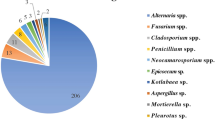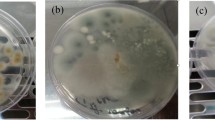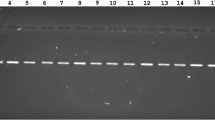Abstract
Eighteen indigenous fungal isolates has been successfully isolated from samples of used motor oil, top five centimetres of soil and drainage water contaminated with used motor oil. All of the pure fungal isolates obtained were identified, characterized and subjected to preliminary screening by evaluating the average growth rate of each fungal isolates on minimal media containing 1% (v/v) used motor oil. Trichoderma asperellum strain TUB F-1067 (SA4), Trichoderma asperellum strain Tr48 (SA5), Trichoderma asperellum strain TUB F-756 (SA6), Penicillium species (P1), and Aspergillus species (P9) were further selected for their hydrocarbon biodegradation potential. Among these five fungal isolates selected, P1 strain presented a significant degree of degradation by degrading almost all of the n-alkanes (n-C-15 to n-C-23 range) present in the used motor oil, thus of greater potential in degrading the aliphatic hydrocarbon compounds of used motor oil.














Similar content being viewed by others
Abbreviations
- PAHs:
-
Polyaromatic hydrocarbons
- MEA:
-
Malt extract agar
- GC-FID:
-
Gas Chromatography Flame Ionization Detector
- BSA:
-
Bovine serum albumin
- g:
-
Gram
- ml:
-
Mililiter
- rpm:
-
Rotation per minute
References
April TM, Fought JM, Currah RS (2000) Hydrocarbon-degrading filamentous fungi isolated from flare pit soils in northern and western Canada. Can J Microbiol 46:38–49. doi:10.1139/cjm-46-1-38
April TM, Abbott SP, Foght JM, Currah RS (1998) Degradation of hydrocarbons in crude oil by the ascomycete Pseudallescheria boydii (Microascaceae). Can J Microbiol 44:270–278
Boonchan S, Britz ML, Stantley GA (2000) Degradation and mineralization of high-molecular-weight polycyclic aromatic hydrocarbons by defined fungal-bacterial cocultures. Appl Environ Microb 66(3):1007–1019
Bumpus JA, Tien M, Wright D, Aust SD (1985) Oxidation of persistent environmental pollutants by a white rot fungus. Science 228:1434–1436. doi:10.1126/science.3925550
Bumpus JA (1989) Biodegradation of polycyclic aromatic hydrocarbons by Phanerochaete chrysosporium. Appl Environ Microbiol 55:154–158
Cerniglia CE, Sutherland JB (2001) Bioremediation of polycyclic aromatic hydrocarbons by ligninolytic and non-ligninolytic fungi. In: Gadd GM (ed) Fungi in bioremediation. Cambridge University Press, Cambridge, pp 136–187
Chaillan F, Le Fleche A, Bury E, Phantavong Y, Grimont P, Saliot A et al (2004) Identification and biodegradation potential of tropical aerobic hydrocarbon-degrading microorganisms. Res Microbiol 155(7):587–595. doi:10.1016/j.resmic.2004.04.006
Clemente AR, Anazawa TA, Durrant LR (2001) Biodegradation of polycyclic aromatic hydrocarbons by soil fungi. Braz J Microbiol 32:255–261. doi:10.1590/S1517-83822001000400001
Colombo JC, Cabello M, Arambarri M (1996) Biodegradation of aliphatic and aromatic hydrocarbons by natural soil microflora and pure cultures of imperfect and ligninolytic fungi. Environ Pollut 94:355–362. doi:10.1016/S0269-7491(96)00044-9
Launen L, Pinto L, Wiebe C, Kiehlmann E, Moore M (1995) The oxidation of pyrene and benzo[a]pyrene by nonbasidiomycete soil fungi. Can J Microbiol 41:477–488
Mesyami P, Baheri M (2003) Pre-screening of fungi and bulking agents for contaminated soil bioremediation. Adv Environ Res 7:881–887. doi:10.1016/S1093-0191(02)00083-7
Molla AH, Fakhru’l-Razi A, Abd-Aziz S, Hanafi MM, Poychoudhury PK, Alam MZ (2002) A potential resource for bioconversion of domestic wastewater sludge. Bioresour Technol 85(3):263–272. doi:10.1016/S0960-8524(02)00117-7
Novotny C, Erbanova P, Sasek V, Kubatova A, Cajthaml T, Lang E et al (1999) Extracellular oxidative enzyme production and PAH removal in soil by exploratory mycelium of white rot fungi. Biodegradation 10:159–168. doi:10.1023/A:1008324111558
Plohl K, Leskovšek H, Bricelj M (2002) Biological degradation of motor oil in water. Acta Chim Slov 49:279–289
Prenafeta-Boldú FX, Kuhn A, Luykx D, Anke H, van Groenestijn JW, de Bont JAM (2001) Isolation and characterisation of fungi growing on volatile aromatic hydrocarbons as their sole carbon and energy source. Mycol Res 105:477–484
Santos VL, Linardi VR (2004) Biodegradation of phenol by a filamentous fungi isolated from industrial effluents-identificqation and degradation potential. Process Biochem 39:1001–1006
Santos EO, Centeno da Rosa CF, dos Passos CT, Sanzo AVL, de Medeiros Burkert JF, Kalil SJ et al (2008) Pre-screening of filamentous fungi isolated from a contaminated site in Southern Brazil for bioaugmentation purposes. Afr J Biotechnol 7(9):1314–1317
Saraswathy A, Hallberg R (2002) Degradation of pyrene by indigenous fungi from a former gaswork site. FEMS Microbiol Lett 210:227–232. doi:10.1111/j.1574-6968.2002.tb11185.x
Saraswathy A, Hallberg R (2005) Mycelial pellet formation by Penicillium ochrochloron species due to exposure to pyrene. Microbiol Res 160:375–383. doi:10.1016/j.micres.2005.03.001
Yamada K, Mukumoto H, Katsuyama Y, Tani Y (2002) Degradation of long-chain alkanes by a polyethelene-degrading fungus, Penicillium simplicissimum YK. Enzyme Microb Technol 30:828–831. doi:10.1016/S0141-0229(02)00065-0
Acknowledgements
The authors wished to thank Associate Prof. Dr. Zani Assim for helping with the analysis of the hydrocarbon and the use of gas chromatography with flame-ionization detector (GC-FID) equipment. This research project is funded and part of the research consultancy project between Universiti Malaysia Sarawak (UNIMAS) and Enggang Services and Product (ESP) Sdn Bhd (Grant No: UNIMAS/18-02/09-01.14).
Author information
Authors and Affiliations
Corresponding author
Additional information
The authors would like to certify that the work have not been sent/considered to be published in other journals.
Rights and permissions
About this article
Cite this article
Husaini, A., Roslan, H.A., Hii, K.S.Y. et al. Biodegradation of aliphatic hydrocarbon by indigenous fungi isolated from used motor oil contaminated sites. World J Microbiol Biotechnol 24, 2789–2797 (2008). https://doi.org/10.1007/s11274-008-9806-3
Received:
Accepted:
Published:
Issue Date:
DOI: https://doi.org/10.1007/s11274-008-9806-3




